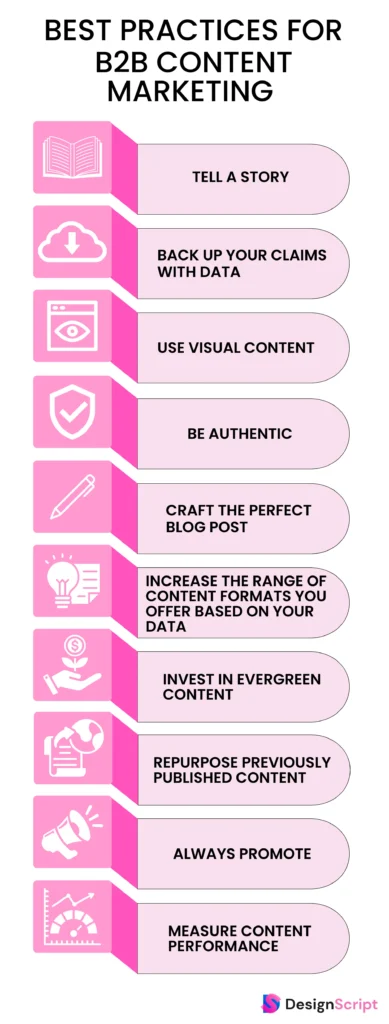How To Build a B2B Content Marketing Strategy (Top 9 Formats)
Did you know? B2B marketing teams reflecting the highest success rates spend 40% of their marketing budget on content marketing.
What is so great about content marketing that even B2B companies are using it? We’ve heard of B2C companies utilizing content to spread the word about their products. But to hear that even B2B companies have jumped on the content marketing bandwagon piques our interests.
If you want your audience to do business with you and not your competitors, you should get the hang of B2B content marketing. Though, it’s not child’s play. Creating content itself is a grinding process, let alone marketing it.
But, we are here to help. If you fancy creating a slick content marketing strategy, you’re at the right place! Read further to know what it is, why it is important, how to build one, top formats, stats, best practices, and examples.
Table of Content
- What Is B2B Content Marketing?
- Why Is Content Marketing Important for B2B Companies?
- Build your B2B Content Marketing Strategy
- Top Content Formats That Work For B2B Businesses
- Top B2B content marketing statistics
- Best Practices for B2B Content Marketing
- 1. Tell a story
- 2. Back up your claims with data
- 3. Use visual content
- 4. Be authentic
- 5. Craft the perfect blog post
- 6. Increase the range of content formats you offer based on your data
- 7. Invest in evergreen content
- 8. Repurpose previously published content
- 9. Always promote
- 10. Measure content performance
- Examples of Great B2B Content Marketing
- Reach The Zenith With B2B Content Marketing
- FAQs
What Is B2B Content Marketing?

B2B content marketing revolves around one primary goal i.e. building brand awareness and finding customers. You may define it as a strategy that consists of three stages- content creation, sharing, and promotion. The content is specifically designed to draw in and intrigue a business audience.
Here, with B2B content marketing, you focus on:
- Targeting business clientele
- Proving your experience, knowledge, and aptitude
- Persuading organizations to work with you
The benefits of content marketing is that it helps drive leads and conversions for your business. Wondering about the common forms for content marketing B2B? Blog posts, podcasts, email newsletters, and infographics are just a few types of content marketing formats.
Why Is Content Marketing Important for B2B Companies?

If you want to generate a great ROI, content marketing will surely lead to success. Other than this, you might consider B2B marketing as a niche since it is different from mass marketing. The customers are fewer than B2C but the catch here is that value per customer is way higher.
Now, what do the stats suggest? According to surveys, 74% of B2B customers prefer conducting online research before actually making an offline purchase decision. Hence, making informative and compelling content is the key here. Content that sells displays your expertise, and services attract more B2B clients.
Content marketing is also affordable and efficient. It communicates better with your target audience. Creating opportunities for collaborations and gaining more exposure is another aspect of B2B content marketing. And it is worth noting. And this is where we know how important it is for all the B2B companies out there!
Build your B2B Content Marketing Strategy
Building a B2B content strategy is an art. You cannot just put or combine some fancy words to get done with it. It requires proper research, process, tactics, dos & don’ts, and much more. So, how to create a content marketing strategy that works? Here’s your answer:

1. Know Your Audience and Their Needs
Without exactly knowing who your audience is and what their needs are, it’s pointless to create a strategy, isn’t it? Thus, the user base acts as a foundation for your content strategy.
Now, you’re not only creating just a content strategy for some people but, you’re creating it to meet their needs. Understanding this point is important. This is because the entire objective of producing content is turning your target audience into paying customers. Let’s see how can we make this process easy:
- The first step is always to curate buyer personas.
- Secondly, divide up your potential clients into smaller groups. You can do this depending on factors like purchase behavior.
- Choose whether you want to focus on one or two particular segments, or whether you want to target all of these subcategories.
- You can modify your content to meet your audience’s unique needs once you’ve recognized who they are, and what they want.
2. Use Micro-Targeting To Channelize Focus
Micro-targeting can uncover important details about buyer behavior. For example- their preferences, and search terms or keywords they like.
Since you have already identified your target audience and their needs, you’re prepared to move on to the next step. This is where you need to hunt down brands online and increase your brand recognition. But how do you make sure that the right people consume your content? The idea is to use the appropriate short and long-tail keywords. We call this process micro-targeting and it works as the analytics data. How can you make it easier for your audience to find you on Google and other search engines? Simple – by incorporating a range of high-searched keywords within your content.
Well-researched keywords can help you rank higher on the website. And reach your potential target audience effectively.
3. Perform Competitor Research
Competitor research is an integral part of any business strategy creation process. If your niche is not too specific, there is a good probability that you have a lot of rivals battling for the attention of your audience.
Finding out what makes them successful and what they are providing to your customer base can be of great help. What makes you unique in the market? You need a distinct unique selling proposition (USP), to attract clients. It’s time to consider what you could do better than your competition. Emphasize what makes you different while you’re selling your goods and services to prospects. Here’s how you can do it:
- Identifying and evaluating your competitors
- Make a note of their strengths and weaknesses
- Establish your company’s unique selling proposition (USP) by outlining your strengths
4. Define Your Goals
Clearly established goals can help you track your progress in any effective marketing campaign.
Wondering how you can pick the right objectives? The answer is simple- play smart not hard. A smart approach with clear, quantifiable, attainable, pertinent, and time-bound goals is what you need to follow.
In other words, you need to establish a specific, attainable objective that you can accomplish in a predetermined time. The outcomes are measurable, so you can track your progress. And determine whether you’re succeeding in achieving the set goals.
Ask yourself these questions to know it better:
- What are you trying to accomplish?
- What actions will you take to achieve your goal?
- How to track successful goals?
5. Create Content with Multiple Layers
Yes, words are wonderful. After all, your goal is to dazzle your audience and show off your professional knowledge. However, reading too much text might be intimidating. If someone is reading your content and finds line after line of continuous text, you risk losing their interest.
But what’s the solution then? It’s dividing your content into layers. You essentially use media, such as text, videos, and images. This is to create a visually appealing user experience when you use multi-layered content. What you’re dealing with is a set of busy, professional business people. To hold their attention is a challenge. Therefore, ensure that your company creates a mark. Making your content intriguing and displaying it interestingly will surely take you to newer heights.
6. Track Your Performance
How can you possibly track your results? Employing tools like Google Analytics can help you track your progress.
Metric tracking provides important information about what works and what doesn’t. You can focus your efforts there and build your business more successfully once you know what content is most helpful in those places.
If you haven’t achieved any performance targets, don’t worry. Not everything you try will succeed. Not all advertisements will result in leads. Collaborations can fall through, and some content may get overlooked.
It’s common. Keep in mind that you’re experimenting with multiple approaches. So, if something isn’t working, just change the direction of your content marketing strategy. And move on with another approach.
7. Focus on Link Building and Collaboration
Want to increase brand awareness? But not sure how to? Think about working with other companies. The idea here is to make and accept some guest posts, specifically.
You may be wondering-
How allowing another business owner to post on your website can assist you in achieving your marketing objectives. Yet, this is your chance to show your audience your connections.
What if your audience notices that other industry titans want to work with you? They’ll instantly have more faith in you. It also generates credibility. This will increase their inclination to consider using your services.
Say, nevertheless, that you would want to write a guest article for another website. It’s a great idea! In essence, the post is free advertising for your brand in addition to increasing your brand awareness. And authority within your niche will be in your favor!
8. Promote Your Content Across Different Platforms
Where do your potential customers spend their time? Your focus should now be on reaching these potential customers as part of a focused marketing campaign since you are already at this final step. Finding the best platform could benefit your brand in many ways:
- Boosting engagement
- Reaching a wider audience
- Garnering more revenue
The best way to reach these potential customers will depend on your audience’s demographics. Start by making your website easier for search engines to find. It is wise to optimize your sites for SEO. It should include meta descriptions, alt text with your photos, and keywords. This is crucial if you want to get a first-page search ranking for your chosen keywords.
Social media is a platform widely used all over the world. Making great use of it and including it in your content marketing funnel can scale up your sales ultimately.
Top Content Formats That Work For B2B Businesses

Here are the top content formats you should consider using,
1. Blog Posts
Always write blog posts in the first person. Your blog posts should present a knowledgeable viewpoint. Always adhere to SEO best practices. Plus, include relevant keywords to capitalize on the subjects that your target audience is most interested in.
2. Infographics
These illustrative representations condense information into a chart or diagram. For example, procedures or data. Infographics should be appealing but simple to understand.
3. Customer Testimonials & Case Studies
Utilize reviews, or recommendations from prior clients to establish credibility. This is more convincing to potential customers wanting to confirm your credentials. It’s so because it is from a non-biased source.
4. Whitepapers
Whitepapers are authoritative publications that investigate complicated problems and make significant recommendations. Technically, these long-form papers should systematically offer all relevant data.
5. Webinars
Webinars are live online presentations that stream video (or occasionally audio-only) content. These presentations can help showcase the expert knowledge of your company. Moreover, webinars are a great source of interaction and engagement. Hence, allowing potential customers to interact with your brand in real-time can be another advantage of holding webinars.
6. Podcasting
Podcasts and other episodic content are excellent for attracting new viewers. It’s trending these days and is the new norm of this modern world. To attract an audience, choosing a popular topic or framework can be beneficial.
7. How-Tos
These fact-based instructive articles draw on first-hand knowledge and original research. How-to guides, when written well, provide your potential consumers with knowledge. This is not the entire detail but only what they need to comprehend the problem at hand. This will make them seek more answers and they’ll contact your brand, resulting in communication.
8. Features
Long-form articles that provide insightful, intriguing commentary are excellent for involving your audience. And starting a conversation. The purpose of features is to establish your brand as the authority, and pique readers’ interest in the underlying themes. And hopefully, compel them to share your content even more.
9. Email Newsletters
A regular newsletter issue calendar is a terrific approach to keep in front of both current and potential clients. To establish yourself as a lively and knowledgeable participant in your professional community, be sure to incorporate important news and event information.
Top B2B content marketing statistics

Coming down to the B2B content marketing stats, let’s highlight some of the top ones here.
- The top 5 formats that B2B marketers employ as a route to deliver content for advertising purposes are email (93%), social media (92%), blog posts (79%), real-life and in-person events (56%), and virtual events (55%). Moreover, according to the Content Marketing Institute, the most profitable B2B businesses and agencies promote their content using all these 5 formats.
- 92% of B2B and B2C marketers consider the content they create to be their most important marketing asset.
- The fact is that content marketing is more affordable by 62% than conventional marketing strategies. Yet, research has shown that using marketing content results in 3 times as many leads as using conventional marketing strategies.
- A desktop or laptop is still the best preference of 62% of B2B decision-makers for content consumption.
- An email newsletter is a key component of content marketing for 77% of B2B agencies and businesses.
- Surprisingly, just 42% of B2B content marketing carries out audience research by personally contacting its target audience.
Check out our post with more content marketing statistics.
Best Practices for B2B Content Marketing
The methodology and marketing strategies are constantly changing. Yet, the underlying ideas are timeless. Here’s a look at some of the best B2B content marketing tips that work like a charm!

1. Tell a story
People love stories as they feel like they’re part of the story and that what happens next will affect them too. This is called a ‘tell a story’ approach to content marketing and helps you engage your audience and retain them on your blog. Longer engagement leads to more opportunities for you to pitch your products or services. So, use this trait to your advantage.
2. Back up your claims with data
Now, this may seem odd to include in the list, but data is the ultimate king in marketing. The more you have, the easier it will be to prove your points. Using data to support your claims can help you craft more authoritative content and cut through the clutter.
3. Use visual content
Including visuals in your content will drastically increase the audience’s likelihood to engage with you and your content piece will look less text-heavy. Images can add a lot of life to your content, whether it’s a graphic, a table, or a cartoon. Therefore, this is one of the most effective content marketing tactics.
4. Be authentic
As you saw above, people love stories. However, they also love authenticity. When you post photos and videos of yourself, you can connect with your readers on a more personal level. Needless to say, posting authentic content will help you build trust with your target audience.
5. Craft the perfect blog post
If you’re putting a blog post together, ensure everything is perfect. From the headline, images, and font to the call-to-action, imagery, and length, you’ll need to focus on every aspect to create a perfect piece. Also, check the flow of the blog and proofread it.
6. Increase the range of content formats you offer based on your data
Expanding your content into different media is a terrific method to profit from what you already know is effective. Therefore, be sure to stay up to date with your content performance data!
7. Invest in evergreen content
Evergreen content is so useful because it never becomes outdated. You could theoretically use something once you’ve invested in its production for all of your time.
8. Repurpose previously published content
The most effective content marketing strategies achieve the ideal balance between new, original content and polished, existing published content. Don’t think of this as weird. This is because your older content will always be fresh to someone. Repurposing existing content is a smart and powerful marketing tactic!
9. Always promote
Poor advertising is the greatest blunder businesses make when it comes to their content. The best moment to advertise a new piece of content is undoubtedly when it first appears during a specific period. But unlike some shampoo, your content has a considerably longer shelf life.
For instance, if you launch a new idea in March, you should have a strategy in place for the following few months, if not years.
10. Measure content performance
Your content needs to be effectively tested, reviewed, and measured constantly. Why? The reason is the ever-evolving trends and needs of your customer. A content marketing campaign should never be haphazard. Always keep a check, follow, and evaluate it.
Examples of Great B2B Content Marketing
Let’s take a look at the top B2B content marketing examples,
HubSpot
We know HubSpot as the most outstanding all-around B2B technology marketing firm. HubSpot offers various distinctive and helpful tools to ensure information flow. It leverages Twitter to promote its products.
The Strategy: HubSpot’s strategy is quite straightforward. To address various stages of the funnel, they produced two different sorts of content:
- Their blog educates small businesses on inbound marketing to bring visitors to the top of the funnel.
- A library of eBooks, case studies, webinars, quizzes, and marketing materials in their resources area aims at visitors in the middle and bottom of the sales funnel.
The Result: In just 10 years, they went from a sponsored to a publicly traded company. They developed a value of over a billion dollars. Thanks to their content marketing, which is a significant source of traffic.
SAP
Asset-intensive B2B organizations can create an engaging and reliable user experience. Everything across all touchpoints with SAP. This includes sales, marketing, purchasing, and service. SAP is consistent with its content management.
The Strategy: SAP focussed on segmentation that comprised the following:
1. Content marketing tailored to 19 consumer segments
2. Specific messaging that addressed issues specific to each industry
3. Solution-based content for each category that highlighted the advantages of their product for that industry.
4. Using the appropriate content for each target audience, including account-based marketing, outbound and responder calls, emails, tweets, blogs, LinkedIn status updates, and their own SAP Community Network.
The Results: SAP recorded marketing-related operations of $3,675,000 and marketing-related pipeline growth of $50,037,709 respectively.
WP Engine
The WordPress platform provides businesses of all sizes with adaptability, productivity, expertise, and integrations.
You can also call it WP Engine.
- The Marketing Strategy: WP Engine’s extremely targeted strategy for content marketing has divided its efforts into various segments that include:
- Their Product: Highlighted recent company news and latest features.
- Their Industry: They assisted clients in developing their web presence with a particular emphasis on WordPress users.
- Impact On Business: Helped individuals utilize their online presence to drive growth.
- Power Output: Establishing a community that focuses more on serving as a support for WordPress users and less on discussing the company.
- Support: Providing clients with written and audio-visual content to assist in problem-solving.
The Result: Their content addressed the unique concerns of their clients in various categories. They did this by concentrating on particular issues and pain spots. They successfully earned more than $40 million while acquiring 300,000 sites throughout 128 nations.
Reach The Zenith With B2B Content Marketing
It’s challenging to execute effective marketing. Marketers have a lot to consider when creating their marketing plan. This includes creative requirements, financial constraints, and channel selections. Marketing is ineffective if you don’t consider your audience. And no other audience is as demanding as business clients. If your marketing doesn’t explain how your company may benefit from theirs, do this-
Consider refocusing your B2B content marketing efforts to find them.
Hope you now know why content marketing is important. Try using our inputs and see how you can build your B2B content marketing process.
FAQs
B2B businesses can prove through content marketing that they share the same values as their clients. Building relationships is crucial in B2B since you rarely sell in large quantities as B2C businesses might.
You may employ content marketing for B2B by doing market research on your target audience. Also, picking the most appropriate B2B content distribution channels helps. Developing high-quality content, & experimenting with A/B testing is also beneficial. Monitoring your B2B content marketing efforts is the last step.
It assists in understanding your audience and selecting your primary content formats & channels. And selecting fascinating themes. Also, it helps in systematizing your content process, tracking leads, and micro-metrics

